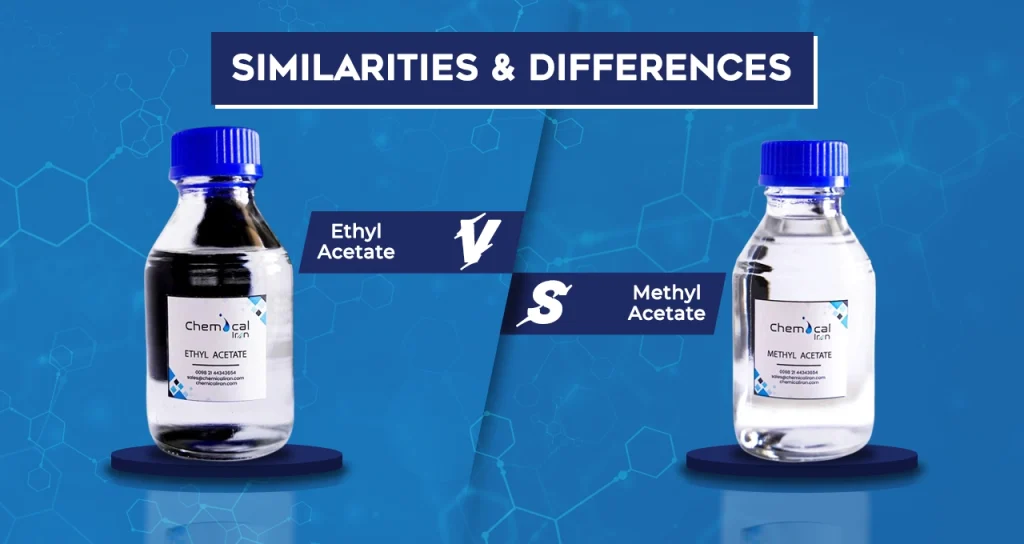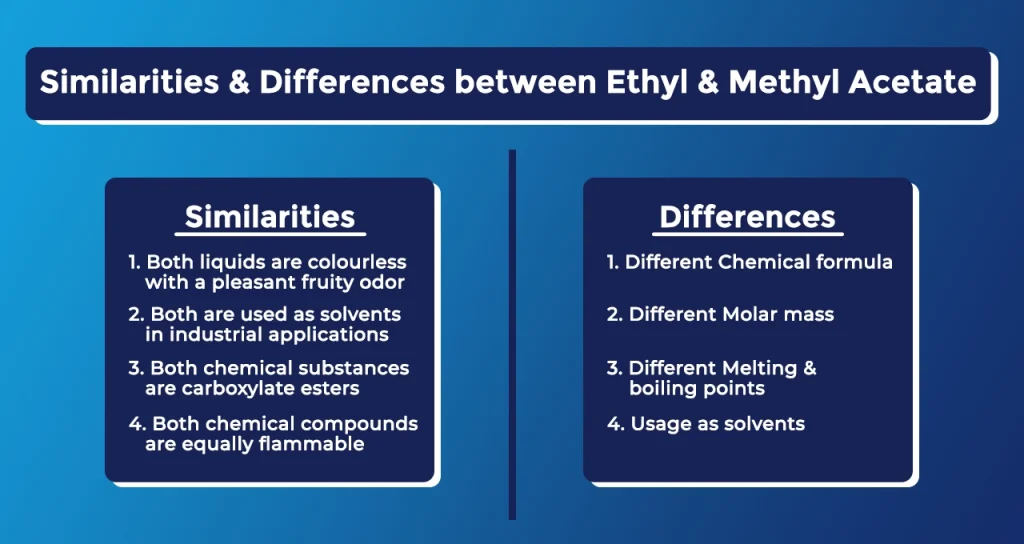Ethyl and Methyl Acetate – both organic chemical compounds are attached to an acetate group. Here, acetate is an anion created from acetic acid. It forms after the removal of hydrogen atoms in the carboxylic acid group. So, although these two chemical substances are closely related when it comes to physical and chemical properties, they have some significant differences. In today’s blog, we will delve into this. Let’s get started.

Ethyl Acetate and Methyl Acetate: Similarities and Differences
Ethyl acetate (CH3CH2COOCH3) is an organic chemical compound formed by the interaction between an ethyl group and a carboxyl group, which makes it the ester of acetic acid and ethanol. It is a colorless liquid at room temperature with a fruity odor, mostly used as a solvent in industrial applications.
Also, its use in other commercial and industrial applications is wide due to its pleasant fragrance, low cost, and low toxicity, including:
- Used as solvent in varnishes, paints, adhesives, and dyes
- As a food additive to extract flavor compounds in the food industry
- The prime ingredient in perfumes, nail paint removers, and artificial food flavors in cosmetics and fragrances
- Employed in laboratory applications for extractions and analytical processes because of its solvent properties
- Widely used in oral medicines as pharmaceutical formulations
On the contrary, there’s Methyl acetate (CH3COOCH3), also an organic chemical compound, attached to a methyl group. It is formed as an ester bond due to interacting with a methyl group and a carboxyl group. Just like ethyl acetate, it is a colorless substance with a sweet, fruity odor if placed at room temperature.
Also, it becomes poorly water soluble at this temperature, while featuring a high water solubility at a higher temperature. Besides being used as a solvent in industrial applications, this organic chemical compound has other uses, such as:
- Used an intermediate in the plastic and pharmaceutical industry
- Essential ingredients in glues and adhesives
- The solvent in varnishes, paints, and coatings
- Widely used in nail polish removers
- Applied in industrial and automotive coatings as a fast-drying agent

Similarities
Hence, when it comes to similarities between ethyl acetate and methyl acetate, there are more than one to mention:
- Both chemical compounds are colorless liquids at room temperature and come with a pleasant fruity odor.
- Ethyl and methyl acetates are both used as solvents in industrial applications.
- Both chemical substances are carboxylate esters.
- These two organic chemical compounds are equally flammable.
Key Takeaways: with so many similarities, it’s possible to use ethyl acetate as an alternative to methyl acetate or vice-versa in various industrial applications.
Differences
Ethyl and methyl acetates are close cousins in the world of organic chemical compounds. Still, they have some key differences. For instance:
Chemical formula
The chemical formulas of ethyl and methyl acetate are different (CH3CH2COOCH3 and CH3COOCH3) because of their interaction with different groups. However, you can make a chemical test to tell these two substances apart, for example, an iodoform test. Here, it doesn’t react with ethyl acetate, but with the other, it does.
Molar mass
Since both chemical compounds form ester bonds, they have a similar structure. However, ethyl acetate contains additional CH2 (methylene group) in its formulation, making it a little bigger and heavier compared to methyl acetate, which is 88 g/mol and 74 g/mol, respectively.
Melting and boiling points
While these two chemical substances are colorless liquids with a sweet odor at room temperature, ethyl acetate takes a slightly higher temperature to be melted (-83.6°C) or boiled (77°C) compared to methyl acetate (melting point -98°C and boiling point 56.9°C).
Usage as solvents
In industrial applications, like coatings, varnishing, nail polish removers, and painting, both ethyl and methyl acetates are used as solvents, but the former is more widely used due to its lower toxicity. Methyl acetate doesn’t have extensive use.
Key Takeaways: Although there are multiple similarities between these two acetate compounds, some key differences outweigh them in many cases.
In a Nutshell
We hope you understand how ethyl acetate and methyl acetate are related to chemical and physical properties beyond their key differences. And, if you are looking for a reliable methyl and ethyl acetate supplier to buy the best quality chemical compounds for commercial and industrial applications, count on us. At Chemical Iran, we offer top organic chemical substances in bulk at affordable prices. Reach out to us to learn more, or click here to get a quote now!

